I recently spent some time gathering some thoughts and statistics about NCDOT's Piedmont service.
-How it started,
-What it was
-What it is
-Where it's going
-Where it
should go
This is a rehashing of a Twitter thread (
https://twitter.com/oevans82/status/1480672509175513092) over the last day or so.
-----------------
The Piedmont is kind of the poster child for Amtrak's trademark incrementalism. Significant improvements in speed, schedule, and facilities have been achieved since the Carolinian started in 1990 and the Piedmont started in 1995, but it's been slow going, one step at a time. There is an official vision for the corridor, but even at its furthest reach, the vision falls well short of the potential for a corridor with a population of about 7 million (and growing rapidly).
Honestly there isn't much (any?) negative press about the Piedmont that isn't just anti-rail. It's seen, with some justification, almost universally as a major success story for intercity passenger rail service in the US. And I guess that's the core of the disappointment. It has an average speed of ~52mph, 4 round trips per day - and, unimpressive as that is, that counts as a big success by US passenger rail standards
There are quite a few contradictions with this corridor. Things that are considered at the same time a major component of this win or success, but in another light could be seen as a missed opportunity or promise unfulfilled.
- Every station along the line has been (or is being) rebuilt, modernized, upgraded, relocated, or enhanced in a major way!
... but, while stations are nice, they aren't transportation - ideally, you spend as little time in a station as possible.
- They are investing in high platforms!!
... at the endpoints, where it will be a nice amenity, but will do nothing to shorten dwell times or improve service.
- They upgraded the signals to support 90mph!
... but they aren't running trains that fast yet because reasons.
- They are doing major upgrades by rebuilding the platforms at Salisbury and Kannapolis stations!
... but these rebuilt platforms will still be low-level.
- They have double tracked the entire corridor from Greensboro to Charlotte, and added/extended several passing sidings between Greensboro and Raleigh!
... but only added a single round trip, and didn't really see any net improvement in OTP.
- They have revised numerous curves for higher speeds!
... but the schedule has actually gotten slightly slower since 2006.
- They have some of the cleanest, best appointed, most comfortable rolling stock in the country!
... which consists entirely of rebuilt coaches from the 50s and 60s, and rebuilt locomotives from the 80s and 90s
- They have been awarded $157 million in federal grants for brand new rolling stock!
... 2-3 years ago, and nary a peep about how or when this will happen, and they even supposedly considered declining the grants entirely, around the beginning of COVID
The whole NCDOT Rail outfit got started on a shoestring budget, as a scrappy, resourceful operation with a mission of bootstrapping itself and creating something out of nothing, over 30 years ago. At this mission, they have had resounding success - but they have never quite seemed to grow up and shift out of that mode, in spite of plenty of signs that they should now be playing in the big leagues - with significant success in terms of ridership and winning competitive grants.
Before we dive in to some numbers, let's look at a timeline. This is a timeline of NCDOT's ARRA stimulus projects. There was work done before this, and work done after this, but this was the single biggest capital program that's been carried out on the corridor.
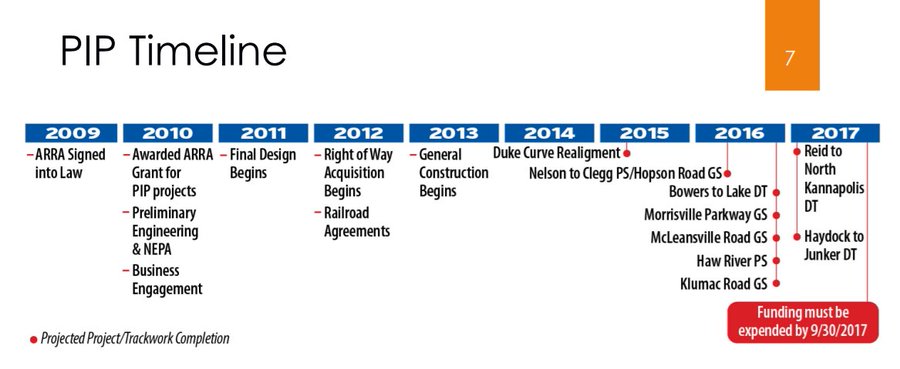
Next, let's look at the schedule and how it's changed over time.
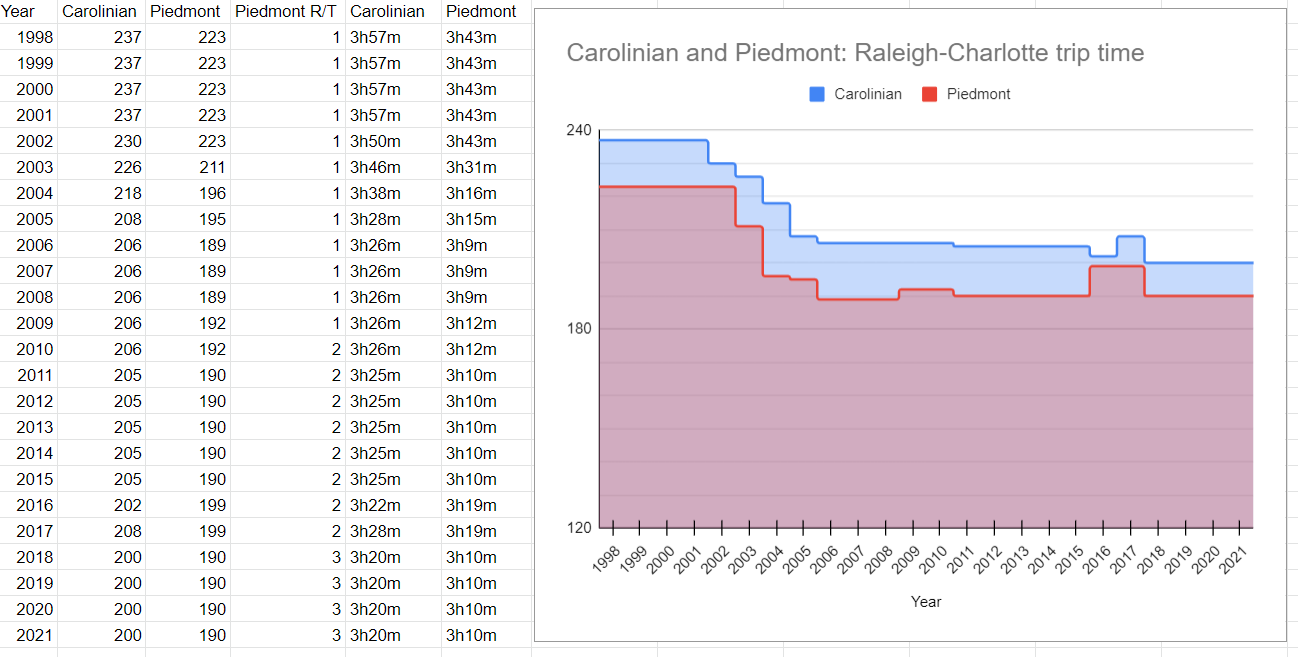
There was big improvement from 2001 to 2006, thanks largely the installation of a CTC signal system allowing speeds to rise from 59mph to 79mph between Raleigh and Greensboro, along with other improvements. Things kind of stagnate after that, as the focus (appears) to shift toward adding more round trips.
Next let's look at On Time Performance (OTP). I was only able to find statistics for 2013-2019.
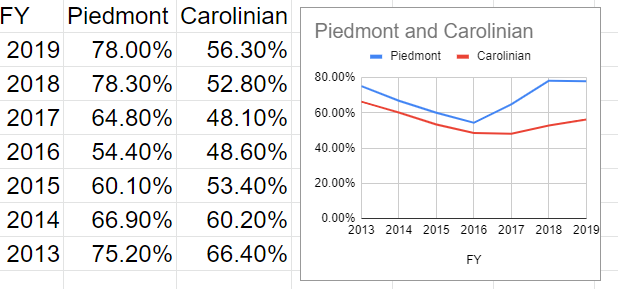
The main story told here for the Piedmont is that OTP suffered significantly while the ARRA projects were under heavy construction from 2014-2017. However, after the construction was complete, there doesn't really seem to have been any significant improvement in overall OTP between pre-ARRA and post-ARRA. The net result of all the capacity improvements (double track, passing sidings, etc) seems to have been to allow OTP to tread water. Disappointing.
How have these factors affected ridership?
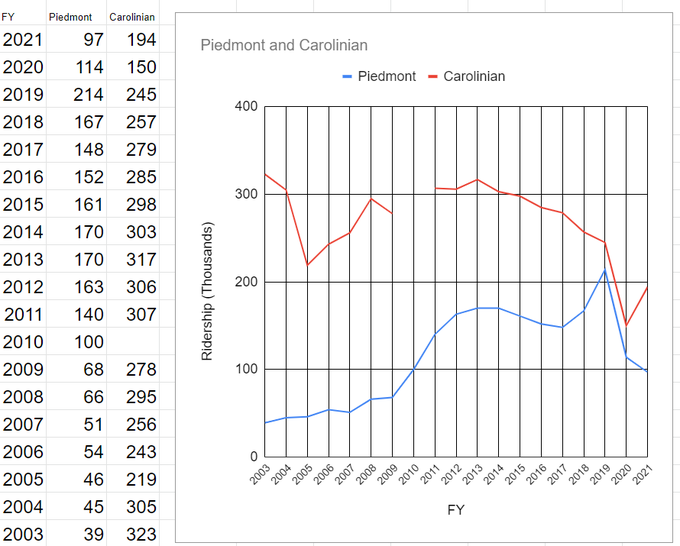
First off, who knows what the Carolinian is doing here? I can't explain it.
But the Piedmont ridership seems to have major inflection points where ridership increases every time a new frequency is added (2010 and 2018) but suffer a dip when OTP is poor (2014-2017). These correlations are astonishingly clear. The overall increase from 39k in FY2003, to 214k in FY2018, is a 5.5x increase - which, ok, yeah, that's really impressive. You'd think, though, that with such an obvious correlation between frequency and ridership, NCDOT would be more gung-ho about adding frequency. But no. It's been slow going.
Summary:
Ridership: Piedmont increased 5.5x from 2003 to 2019!
Frequency: From 1x per day in 1994 (Carolinian only) to 4x per day in 2018 (Carolinian + 3x Piedmont)!
Speed: Big improvement from 1998-2006; ~stagnant since
OTP: Treading water
Spending: About $1 billion, all said and done
So where (metaphorically) is this service headed?
There are some station upgrade projects in progress for Charlotte, Kannapolis, and Salisbury. There are three new-build stations also under consideration (Harrisburg, Lexington, and Hillsborough). And of course more grade separations here and there throughout the corridor. PTC signals were installed due to the mandate, and they supposedly should allow for 90mph operations, but trains haven't been sped up yet. I have no idea why not.
NCDOT was awarded (in 2019 and 2020) $157 million in grant money to buy new trains, but has announced precious little about what they actually plan to do with it. Supposedly the grants do not expire, so I guess they are taking their sweet time planning this procurement.
As for service: NCDOT plans an extra Piedmont round trip once the new Gateway Station opens in Charlotte. That, plus 4 or 5 more round trips that would
supposedly be added if the S-line (direct, "high speed" route from Raleigh to Richmond) were ever built. But that, 9 or 10 intercity trains per day, is the current endgame for the corridor. This seems ... unambitious, for a corridor of 7 million people, that's as economically, culturally, and politically "joined at the hip" as the North Carolina Piedmont. It seems like this vision was mostly written sometime between 1996 and 2002, and hasn't evolved much since.
Where could it, or should it go?
If we go back to the genesis of NC's state-run passenger rail program, you'll find that around 1990, shortly after the Carolinian started daily service, Governor Jim Hunt articulated a vision for hourly service, and 2 hour running times between Raleigh and Charlotte. A big vision WAS there, at some point - but somewhere, somehow, we've gotten mired along the way in a bog of timid incrementalism.
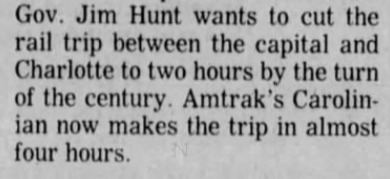
What would 2 hour Raleigh-Charlotte service entail? Basically, somewhere along the lines of Brightline, or the Boston-NYC NEC: 85mph average speeds. That's "Upgraded Conventional Rail" territory, not even true HSR. (True HSR would travel between Raleigh and Charlotte in closer to
one hour.) But somehow, even that - "upgraded conventional rail" - is out of reach. So we're stuck with a few trips a day, ~50mph average speeds uncompetitive with driving, and refurbished 60 year old trains.
Now, I have to acknowledge, that in spite of the half-fulfilled promises and missed opportunities - NCDOT nevertheless has one of the best-run, most successful, most comprehensive, most competent, state-run passenger rail programs in the US. I give them credit for going as far as they have within such a suffocating framework!
However - if this is "as good as it gets," then when it comes to having actual, functional, useful, intercity passenger rail in the US - we're pretty much screwed.






